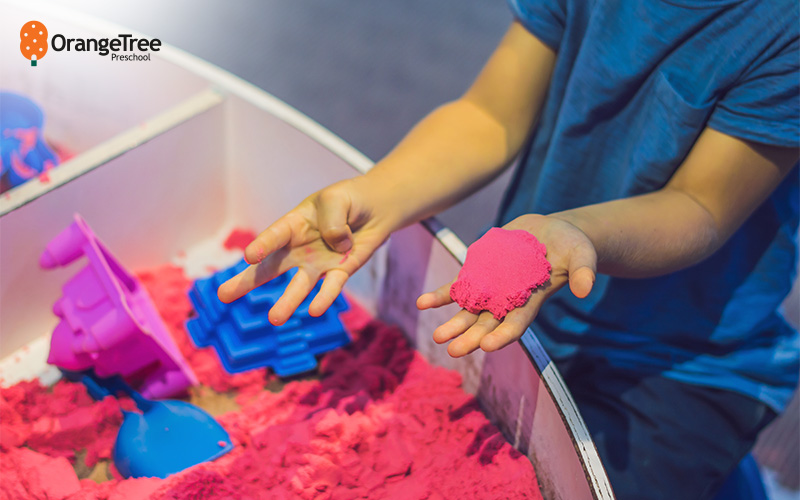
The Power of Sensory Play: How Each Sense Shapes Your Child’s Growth
26 September 2025
Introduction
Sensory play may look like simple fun on the surface, but beneath the squishing, splashing, and exploring is a deeper force at work. Engaging the senses of touch, sight, sound, smell, and taste, sensory activities give children a hands-on way to interact with and interpret the world around them. Today, they are recognised as one of the most enriching early childhood development activities.
Unlike free play, which is open-ended and spontaneous, sensory play is intentional. It sparks curiosity, encourages experimentation, and builds lasting neural connections that support everything from motor skills to emotional regulation.
This article will explain how the process activates children’s brains and shapes their growth in remarkable, lasting ways.
Key Takeaways:
- What is Sensory Play and Why is it Important?
It is a hands-on experience that stimulates a child’s senses—touch, sight, sound, smell, and taste. It helps young children explore their environment, build neural connections, and develop essential skills like communication, emotional regulation, and motor control.
- When Is the Best Time to Introduce Sensory Activities?
The early years (0–6) are a critical period for sensory development. During this time, the brain is most responsive to sensory input, making it the ideal stage for engaging in activities that support physical, cognitive, and emotional growth.
- What Types of Sensory Activities Can You Try?
Examples include tactile tasks like playing with playdough and sand bins, auditory tasks like sound tubes, taste and smell exploration with food, vestibular tasks like swinging or rocking, and proprioceptive activities such as climbing and lifting. Each activity targets different senses and supports specific learning outcomes.
- How Can Parents and Educators Make Sensory Activities Effective?
Keep materials age-appropriate and safe, rotate environments to keep things exciting, involve children in setup to increase engagement, and embrace the mess as part of the learning.
Overview of Sensory Play
What Is Sensory Play?
Sensory play encompasses any activity that stimulates a child’s senses: touch, sight, sound, smell, or taste. It often incorporates movement, balance, and spatial awareness. While it may seem simple or even chaotic at times, its purpose is deeply rooted in how young children learn best—through hands-on, sensory-rich experiences.
The concept encourages children to explore their environment, ask questions, experiment with outcomes, and engage in creative problem-solving. From running fingers through sand and listening to different sounds to exploring the texture of playdough, each experience sparks curiosity while helping the brain form new neural connections. These connections become the building blocks for more advanced skills, such as communication, problem-solving, and emotional control.
Why it Matters Most Between Ages 0–6
The early years—from birth to around 6—mark a golden window in a child’s brain development. Often called the sensitive period, this stage is when the brain becomes most responsive to sensory input. At birth, a child’s senses are still developing. It is through repeated, meaningful experiences that these senses become refined and fully integrated.
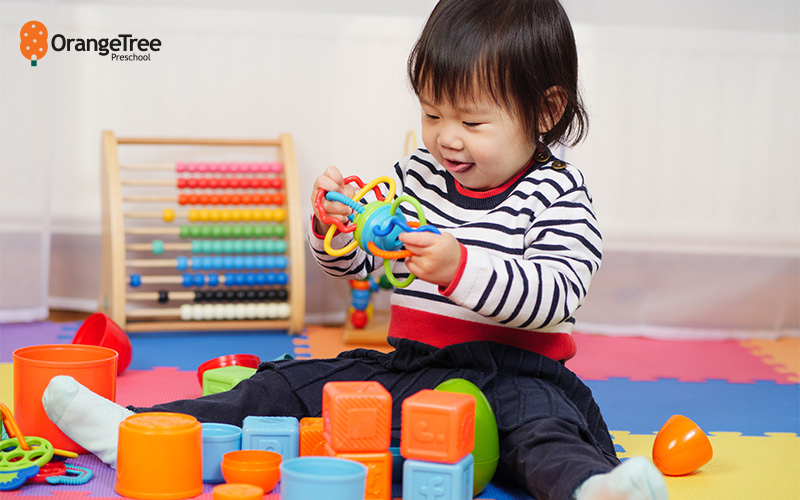
Engaging in sensory play during this time supports far more than just entertainment. It boosts attention span, improves emotional regulation, and strengthens fine and gross motor skills. The more sensory-rich the experience, the broader pathways the brain creates, helping children make better sense of themselves and the world around them.
What are the Key Types of Sensory Play and the Senses They Engage?
Having determined how sensory play shapes early brain development, it’s time to explore its role in engaging a child’s senses. Each type of sensory activity taps into a different sense, nurturing respective areas of growth along the way. These hands-on experiences lay the groundwork for sensory learning for toddlers, helping them respond to the world around them confidently.
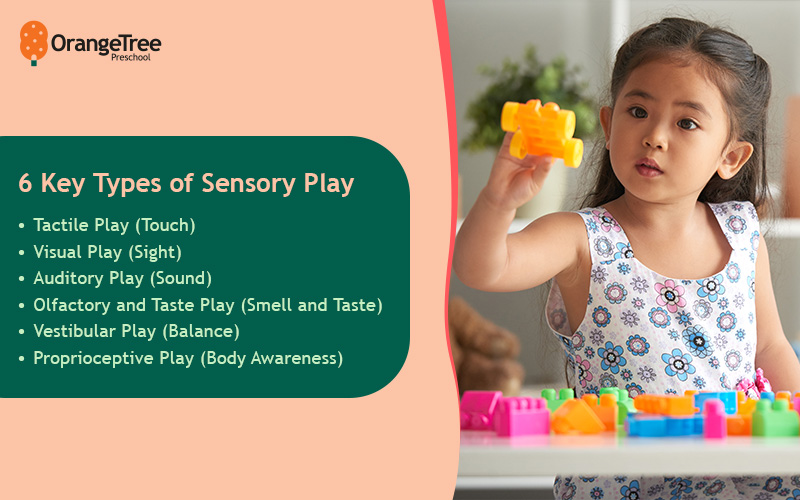
1. Tactile Play (Touch)
Activities such as sand play, water tables, finger painting, and slime allow children to explore different textures, pressures, and temperatures. Tactile play helps refine fine motor skills, improves hand-eye coordination, and builds awareness of how different surfaces feel.
2. Visual Play (Sight)
From sorting colourful objects and exploring light tables to identifying patterns and engaging in shadow play, visual activities strengthen a child’s ability to track movement, differentiate shapes and colours, and sharpen their focus.
3. Auditory Play (Sound)
Drumming, listening to music, shaking maracas, or identifying environmental sounds all fall under auditory play. These activities help children fine-tune their listening skills, distinguish between sounds, and respond appropriately.

4. Olfactory and Taste Play (Smell and Taste)
Engaging the senses of smell and taste can include smelling herbs and spices, tasting a variety of fruits, or exploring scented dough and scent bottles. These experiences enhance sensory discrimination and support memory formation, especially when linked to familiar smells and flavours.
5. Vestibular Play (Balance)
Activities that involve spinning, swinging, rocking, or rolling stimulate the vestibular system, which is responsible for balance and spatial orientation. This type of play helps children regulate their movement and stay physically grounded.
6. Proprioceptive Play (Body Awareness)
Jumping, climbing, pushing, pulling, or lifting heavy objects are forms of proprioceptive play. These activities help children understand their body’s position in space, improve coordination, and regulate energy levels.

Sensory Play vs Messy Play: What’s the Difference?
Sensory play and messy play may look similar but they serve distinct purposes. While both are rich in developmental benefits, how they achieve those outcomes varies greatly. Read on to spot their difference in terms of intent, structure, and learning process.
Sensory play involves purposeful activities designed to stimulate one or more of a child’s senses. These activities are often guided or intentionally set up to achieve specific developmental goals, such as improving fine motor skill development through play.
Examples:
- Colour sorting with pom poms
- Scooping and pouring in a water table
- Playing with scented playdough
- Feeling textured materials like sandpaper or fabric swatches
Messy play, on the other hand, is more open-ended. Focusing on child-led messy play activities, the methodology invites kids to get creative, follow their curiosity, and explore materials without a fixed objective. While sensory input often occurs as a by-product (think sticky fingers or squishy textures), the main goal is discovery through hands-on play ideas.
Examples:
- Making and playing with slime
- Digging through rice or bean bins
- Finger painting without a template
- Cooking up imaginary meals in a mud kitchen
All in all, sensory play is more structured and often adult-guided. It aims to engage specific senses and support areas like motor skills, emotional regulation, and sensory processing. In contrast, messy play prioritises child-led and spontaneous experiences. It values open-ended exploration to boost children’s creativity, curiosity, and confidence.
To make things clearer, here’s a table that distinguishes the duo:
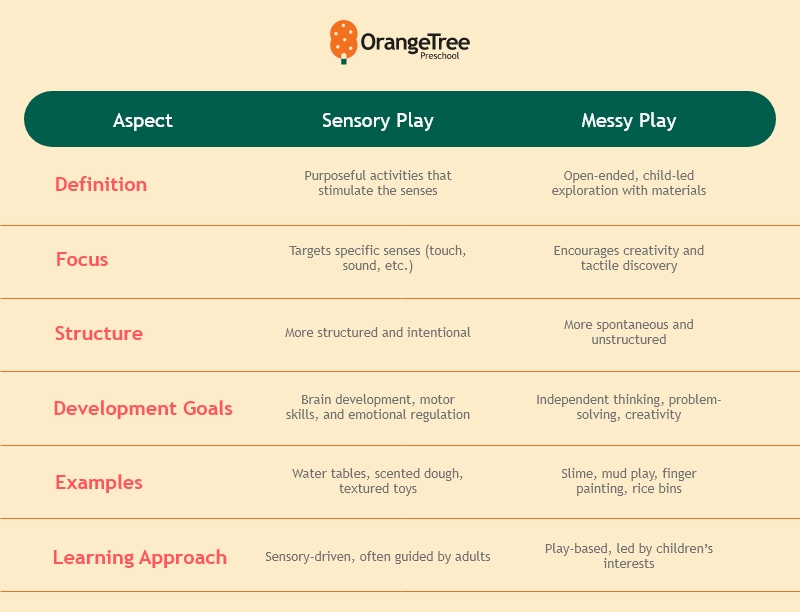
From Play to Progress: The Benefits of Sensory Play
How Sensory Play Supports Growth
In this section, we will look closer at how sensory activities support a child’s development. More than just fun and games, sensory play offers multiple benefits that shape cognitive, physical, social, and emotional growth, making it a powerful addition to any preschool curriculum.
The benefits of sensory exploration go far beyond entertainment by promoting:
1. Cognitive Development
Sensory activities naturally spark curiosity and encourage children to experiment, ask questions, and explore cause-and-effect relationships. These hands-on moments nurture critical thinking and problem-solving skills while also strengthening memory, attention span, and focus. Through repeated sensory input, children gain better insights into how the world works.
2. Motor Skill Development
From scooping beans to lacing beads, sensory play helps fine-tune fine motor skills by improving finger strength and control. On a larger scale, activities like jumping, balancing, or rolling around in soft play areas promote gross motor development, supporting coordination and overall body awareness.
3. Language Development
Sensory play is rich in language opportunities. As children feel, smell, and describe what they experience, they naturally expand their vocabulary. Such hands-on preschool learning encourages them to mention words like “squishy,” “bumpy,” or “icy”, improving both receptive and expressive language skills.
4. Social Skills
Many sensory activities are best enjoyed with others. Sharing a water table or taking turns with textured materials promotes cooperative play, communication, and patience. Through early social interactions, children learn how to cooperate, communicate, and build empathy.
5. Emotional Regulation
Many children may deem sensory play as a calming outlet. Repetitive, tactile activities like squeezing dough, pouring water, or swirling sand can help reduce anxiety and regulate emotions. These soothing experiences are especially helpful for children who become overstimulated or have difficulty expressing themselves.
How to Incorporate Sensory Play at Home or School
Bringing sensory activities into daily routines is easier than you might think. With a few everyday materials and a bit of creativity, parents and educators can create meaningful sensory experiences that support early learning.
1. Sensory Bins
Fill containers with dry rice, beans, or sand and add scoops, cups, and toys for tactile exploration. These bins are great for fine motor development and can be customised for seasonal themes or learning goals.
2. Play Dough
Squishing, rolling, and shaping dough helps build hand strength and creativity. Whether store-bought or homemade, it is a go-to tool for sensory play in preschool classrooms.
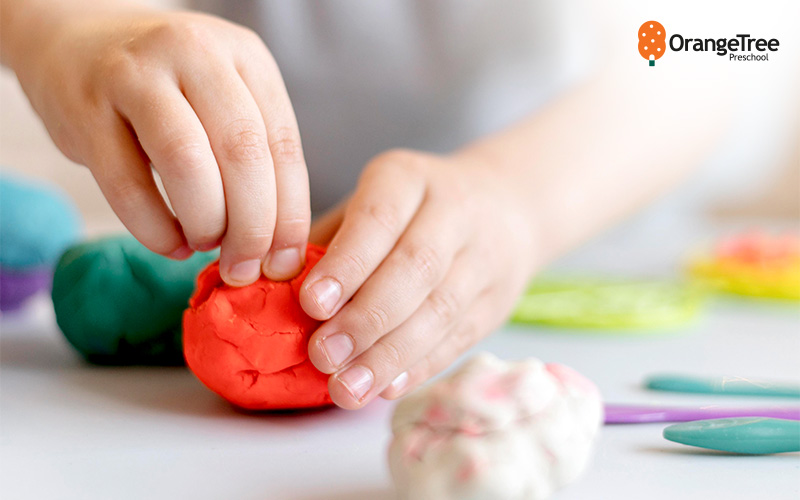
3. Sound Tubes
Use cardboard rolls filled with dried beans, beads, or rice to create DIY “instruments”. Kids love shaking them to discover how different materials sound.
4. Food Play
Let children explore textures and tastes by squashing fruits, smearing yoghurt, or creating edible art with soft foods.
5. Outdoor Play
Activities like walking barefoot on grass, collecting leaves, or playing in the sand offer rich multisensory experiences. Incorporating outdoor play also helps children stay active and connected to nature.
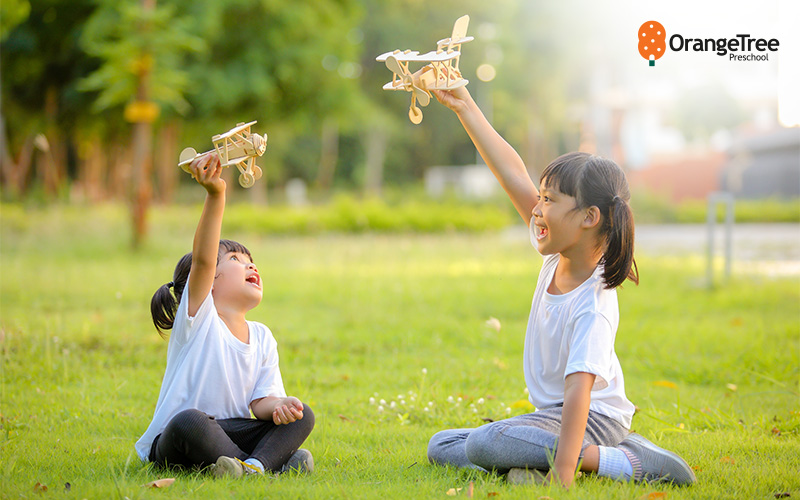
What Parents and Educators Can Do
To maximise the benefits of sensory activities and keep things manageable, here are some useful strategies:
1. Rotate Environments
Switching between indoor and outdoor spaces keeps sensory play fresh and stimulating.
2. Involve Children in Setup
From scooping rice into bins to kneading dough, letting children help with the setup adds another layer of sensory engagement and responsibility.
3. Supervise for Safety
Always ensure materials are clean, non-toxic, and age-appropriate. Keep an eye on toddlers who may put items in their mouths.
4. Keep it Simple
Use trays, mats, or plastic cloths to contain the mess. Remember, a bit of mess is part of the process!
Frequently Asked Questions
1. At what age should I start sensory play with my child?
You can begin simple sensory activities as early as infancy. Babies benefit from sensory stimulation like textured toys and soft music. As toddlers and preschoolers grow, more complex activities, like playdough, sand play, and water tables can be introduced.
2. Is sensory play suitable for children with sensory sensitivities or autism?
Yes, but it should be adapted to the child’s comfort level. Some children may be overstimulated by certain textures or sounds. Offer sensory options in small, manageable doses, and always observe your child’s responses closely.
3. Do I need to buy special materials for sensory activities?
Not at all. Many sensory activities can be done using everyday items at home—rice, pasta, water, sponges, scented herbs, or simple musical instruments. Creativity matters more than cost.
Conclusion
From building cognitive and motor skills to enhancing emotional regulation and social development, early sensory experiences shape how children understand, process, and engage with the world around them. That’s why it’s so important for parents and educators to create consistent, sensory-rich environments—both at home and in school.
At Orange Tree Preschool, we embrace this journey with a warm, enriching environment designed to meet each child where they are. Through our child-centred approach, aligned with ECDA guidelines, we offer developmentally appropriate experiences that spark discovery and nurture growth.
As a trusted Chinese preschool with a focus on bilingual learning and sensory development, we ensure every child receives the attention, care, and stimulation they need to thrive.
Looking for a nurturing start in the west of Singapore? Our preschool in Choa Chu Kang is ready to welcome your child into a world of purposeful play, learning, and joyful exploration.
Contact us to find out more.
